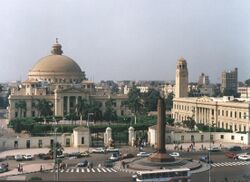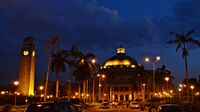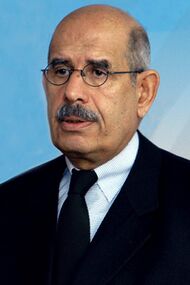Cairo University
Topic: Organization
 From HandWiki - Reading time: 9 min
From HandWiki - Reading time: 9 min
جامعة القاهرة | |
 Thoth, the embodiment of knowledge, hieroglyphs, and wisdom. | |
Former names | Egyptian University Fuad I University |
|---|---|
| Type | Public |
| Established | 1908 |
| President | Mohammed Othman Al Khasht |
Administrative staff | 12,158 |
| Students | 231,584 |
| Location | , Giza , [ ⚑ ] : 30°01′39″N 31°12′37″E / 30.02760°N 31.21014°E |
| Campus | Urban |
| Affiliations | UNIMED |
| Website | cu.edu.eg/ |
Cairo University (Arabic: جامعة القاهرة), also known as the Egyptian University from 1908 to 1940, and King Fuad I University and Fu'ād al-Awwal University from 1940 to 1952, is Egypt's premier public university. Its main campus is in Giza, immediately across the Nile from Cairo. It was founded on 21 December 1908;[1] however, after being housed in various parts of Cairo, its faculties, beginning with the Faculty of Arts, were established on its current main campus in Giza in October 1929. It is the second oldest institution of higher education in Egypt after Al Azhar University, notwithstanding the pre-existing higher professional schools that later became constituent colleges of the university. It was founded and funded as the Egyptian University by a committee of private citizens with royal patronage in 1908 and became a state institution under King Fuad I in 1925.[2] In 1940, four years following his death, the University was renamed King Fuad I University in his honor. It was renamed a second time after the Egyptian revolution of 1952.[1] The University currently enrolls approximately 155,000 students in 20 faculties and 3 institutions.[3][4] It counts three Nobel Laureates among its graduates and is one of the 50 largest institutions of higher education in the world by enrollment.
Concerning the faculty of Engineering, In 2006, the college began implementing the credit hour system in specialties: Construction Engineering, Computer and Telecommunications engineering
In 2007, more programs were developed: mechanical design engineering, architecture, engineering, construction, technology, and petrochemical engineering. Following in 2008, the Construction Engineering program was introduced. In 2009, the Water and Environmental Engineering Program was implemented.
History
Before he retired in 1907, the British representative in Egypt, Lord Cromer remained opposed to the establishment of higher education in the country for fear that it would foment unrest. The University opened as a small private institution in 1908. Its early founding and location made it a model for later universities throughout the Arab world. It was taken over as a state university in 1925, and became Cairo University in 1954.[citation needed]
The university was founded on 21 December 1908, as the result of an effort to establish a national center for higher education. Several constituent colleges preceded the establishment of the university including the College of Engineering (كلية الهندسة) in 1816, which was shut down by the Khedive of Egypt and Sudan, Sa'id Pasha, in 1854. Cairo University was founded as a European-inspired civil university, in contrast to the religious university of Al Azhar, and became the prime indigenous model for other state universities. In 1928, the first group of female students enrolled at the university.[5]
Foundation
At the turn of the century, Egyptian intellectuals and public figures began making calls to establish an Egyptian institute of higher education to provide a modern, professional education to Egyptians. Armenian bureaucrat Yaqub Artin made the first known published reference to establishing an Egyptian university in 1894. In a report, he suggested "the existing higher professional schools could well provide the basis for a university."[6] These higher schools included the School of Management and Languages, established in 1868 (which became the School of Law in 1886), the School of Irrigation and Construction (known as the School of Engineering) in 1866, Dar al-Ulum in 1872, the School of Agriculture in 1867 and the School of Antiquities 1869.[7]
Syrian journalist Jurji Zaydan called for an "Egyptian college school" (madrasa kulliya misriyya) in 1900 in his monthly magazine Al-Hilal. He provided two models for this institute of higher education: the Muhammadan Anglo-Oriental College at Aligarh, India, which delivered a Western-style education in the English language, or the Syrian Protestant College (now the American University of Beirut) in Beirut, run by American missionaries.[8] The new school would provide an alternative to the student missions to Europe begun under Muhammad Ali. Controversy surrounding Zaydan’s publications would later prevent him from taking a teaching post at the University.[9] A number of other prominent Egyptians played a role in the university's foundation. A collection of large landowners, bureaucrats, members of the royal family, and journalists, lawyers, and school teachers including Mustafa Kamil, disciples of Muhammad Abduh such as Qasim Amin and Saad Zaghlul, and eventually Khedive Abbas II and Prince Ahmad Fu’ad I became involved. As Donald M. Reid writes, "Royalist partisans stressed Fu'ad's founding role, Watanists pointed out Mustafa Kamil's call for a university, and Wafdists emphasized the contributions of Saad Zaghlul, Muhammad Abduh, and Qasim Amin."
Wealthy Egyptians began to independently pledge funds to the establishment of a university as early as 1905. Following the Dinshaway incident, Mustafa Kamil al-Ghamrawi, a wealthy notable from Beni Suef, pledged 500 Egyptian pounds towards a university in September 1906. Mustafa Kamil published a call for supplementary funds, while Saad Zaghlul and Qasim Amin arranged a meeting attended by Muhammad Farid and 23 other prominent Egyptians. The members of the meeting founded a committee with Zaghlul as vice-president and Amin as secretary, and all but three pledged at least 100 Egyptian pounds towards the university. However, splinters quickly emerged between the Watanists, the disciples of Abduh and the Royalists, leaving the project in the hands of the Palace.[10] By the time of its establishment in 1908, Prince Fuad I was the rector and only one of the men who had met in 1906 remained in the committee.
Concerning the faculty of engineering In 2006, the college began implementing the credit hour system by launching the following programs: construction engineering, Computer and telecommunications engineering.
In 2007 programs that were developed: mechanical design engineering, architecture engineering and construction technology and petrochemical engineering.
In 2008, it introduced a program: Construction Engineering.
In 2009, it introduced the Water and Environmental Engineering Program.
Challenges to foundation
The British colonial government, particularly Lord Cromer, had long opposed the establishment of such a university. Only a year after his departure from Egypt, under Sir Eldon Gorst, was the Egyptian University finally established. The Egyptian educational system remained neglected by the colonial government under the direction of Lord Cromer.[11] Two decades after the establishment of British rule, education received less than 1 percent of the state budget. Cromer publicly stated that free public education was not an appropriate policy for a nation such as Egypt, although the funds were found to refurbish the law school in Cairo so Egyptians didn't have to go abroad to obtain legal degrees during Sir John Scott's time as Judicial Advisor to the Khedive.[12] Donald M. Reid speculates that this was due to fear that European-style education would fomest political unrest or nationalistic sentiments. Cromer also opposed providing financial aid to the university after the private committee began to pursue the matter independently of the colonial government.
In its early years, the university did not have a campus but rather advertised lectures in the press. Lectures would be held in various palaces and conference halls. After a grand opening ceremony in 1908, it remained on financial insecure footing for a number of years, nearly collapsing during World War I. Upon its founding in 1908, the Egyptian University had a women’s section but this was closed in 1912. Women were first readmitted to the arts faculty in 1928.[13]
Problems during this period also included a lack of professional faculty to fulfill the founders’ educational vision. There were simply no Egyptians with doctoral degrees, the ability to teach in Arabic and a familiarity with Western literature in their fields with whom to fill professorial posts.[14] Thus European Orientalists who lectured in classical Arabic filled many posts until the 1930s. The university also sent its own students on educational missions to obtain the necessary training. First, the university hired Italians Carlo Nallino, David Santillana and Ignazio Guidi, due to King Fuad I’s connections with Italy. Following the departure of the Italians after the invasion of Libya, French orientalists Gaston Wiet and Louis Massignon took up posts on the faculty. The Germans and British were less represented.
In 1925, the university was re-founded and expanded as a state institution under Fuad I. The liberal arts college (kulliyat al-adab) of 1908 was joined with the schools of law and medicine, and a new faculty of science was added. Ahmed Lutfi al-Sayyid became the first president.
Ranking
| University rankings | |
|---|---|
| Global – Overall | |
| ARWU World[15] | 401-500 (2020) |
| CWUR World[16] | 558 (2020-2021) |
| CWTS World[17] | 308 (2020) |
| QS World[18] | 561-570 (2021) |
| THE World[19] | 601–800 (2021) |
| USNWR Global[20] | =427 (2021) |
| Regional – Overall | |
| THE Africa[21] | =14 (2021) |
| USNWR Africa[22] | 6 (2021) |
| National – Overall | |
| ARWU National[15] | 1 (2020) |
| CWTS National[17] | 1 (2020) |
| CWUR National[16] | 1 (2020-21) |
| QS National[18] | 2 (2021) |
| THE National[19] | 4 (2021) |
| USNWR National[20] | 1 (2021) |
Cairo University is usually ranked among the top universities in Egypt, and one of the top universities in Africa.
In QS ranking 2021, Cairo University was ranked the 2nd in Egypt and the 6th across Africa, and it was rated 561-570 worldwide.
In the ARWU 2020 ranking, the university was ranked 1st in Egypt. It was rated 401-500 worldwide.
According to the Center for World University Rankings (CWUR) 2020-21, the university was ranked 1st in Egypt, and the 558th worldwide.
Structure
Cairo University includes a School of Law and a School of Medicine. The Medical School, also known as Kasr Alaini (القصر العيني, Qasr-el-'Ayni), was one of the first medical schools in Africa and the Middle East. Its first building was donated by Alaini Pasha. It has since undergone extensive expansion. The first president of Cairo University, then known as the Egyptian University, was Professor Ahmed Lutfi el-Sayed, who served from 1925 to 1941.[23]
New Central Library
A new Central Library is planned.[24]
Notable alumni
- Abdel Khalek Sarwat Pasha (1873-1928), twice Prime Minister of Egypt.[25]
- Husayn Fawzi Alnajjar, historian, political scientist, and strategist
- Said Ashour, professor of history
- Mohamed Atalla, engineer, inventor of MOSFET (MOS field-effect transistor), pioneer in silicon semiconductors and security systems, founder of Atalla Corporation[26]
- Naima Ilyas al-Ayyubi, first female lawyer in Egypt[27]
- Gamal Aziz, also known as Gamal Mohammed Abdelaziz, Egyptian former President and Chief Operating Officer of Wynn Resorts, and former CEO of MGM Resorts International, indicted as part of the 2019 college admissions bribery scandal
- Hisham Barakat, assassinated Prosecutor General of Egypt
- Boutros Boutros-Ghali, sixth Secretary-General of the United Nations (UN) 1992–1996
- Eli Cohen, Israeli Mossad spy that infiltrated the highest echelons of Syrian Government and instrumental in Israeli success in the Six Day War and other successes
- Taher Elgamal, designer of the ElGamal encryption system and considered "Father of SSL"
- Wael Ghonim, Egyptian activist and figure of the Egyptian Revolution of 2011
- Saddam Hussein, former president of Iraq
- Adly Mansour, Chief Justice of the Supreme Constitutional Court of Egypt
- Mohamed Morsi, deposed President of Egypt
- Amr Moussa, Secretary-General of the Arab League 2001–2011, and president of the Egyptian constitution amendment committee in 2013
- Omar Sharif, actor, nominated for an Academy Award and has won three Golden Globe Awards
- Magdi Yacoub, professor of cardiothoracic surgery at Imperial College London
- Mohamed Shaker El-Markabi, Minister of Electricity and Renewable Energy
- Ayman al-Zawahiri, former practicing surgeon in the Egyptian Army, current leader of the militant organisation al-Qaeda[28][29]
- Yuriko Koike, former Japanese Minister of Defense and first female governor of Tokyo
- Walid Muallem, Deputy Prime Minister and Minister of Foreign Affairs and Expatriates of Syria
Nobel Laureates
- Naguib Mahfouz, Nobel Prize for Literature in 1988
- Yasser Arafat, Nobel Peace Prize in 1994
- Mohamed ElBaradei, Nobel Peace Prize in 2005
See also
- Ahmed Lutfi el-Sayed, first President of Cairo University
- Education in Egypt
- Egyptian universities
- List of Egyptian universities
References
- ↑ 1.0 1.1 "Brief history and development of Cairo University." Cairo University Faculty of Engineering. http://www.eng.cu.edu.eg/CUFE/History/CairoUniversityShortNote/tabid/81/language/en-US/Default.aspx
- ↑ Cuno, Kenneth M. Review: Cairo University and the Making of Modern Egypt by Donald Malcolm Reid. JSTOR. https://www.jstor.org/stable/368175
- ↑ Cairo University. The roots of Cairo University. Arabic language. http://cu.edu.eg/ar/page.php?pg=contentFront/SubSectionData.php&SubSectionId=29 English language. http://cu.edu.eg/page.php?pg=contentFront/SubSectionData.php&SubSectionId=29
- ↑ Faculties of Cairo University
- ↑ Mariz Tudros (18–24 March 1999). "Unity in diversity". Al Ahram Weekly 421. http://weekly.ahram.org.eg/1999/421/li1.htm. Retrieved 28 October 2013.
- ↑ Reid, Donald M. Cairo University and the Making of Modern Egypt. Cambridge: Cambridge UP, 1990. Print. 23.
- ↑ Cairo University. The roots of Cairo University. Arabic language. http://cu.edu.eg/ar/page.php?pg=contentFront/SubSectionData.php&SubSectionId=29
- ↑ Reid, 23
- ↑ Reid, 27
- ↑ Reid, 234.
- ↑ Reid, Donald Malcolm. "Cairo University and the Orientalists." International Journal of Middle East Studies 19.01 (1987): 51-75. Print. 60.
- ↑ Journal of the Society of Comparative legislation, Vol. 1, No2, July 1899, pp. 240-252
- ↑ Cuno, 531
- ↑ Reid, 24.
- ↑ 15.0 15.1 "Academic Ranking of World Universities 2020". http://www.shanghairanking.com/ARWU2020.html.
- ↑ 16.0 16.1 "Center for World University Rankings 2020-2021". https://cwur.org/2020-21.php.
- ↑ 17.0 17.1 "CWTS Leiden Ranking 2020". https://www.leidenranking.com/ranking/2020/list.
- ↑ 18.0 18.1 "QS World University Rankings 2021". https://www.topuniversities.com/university-rankings/world-university-rankings/2021.
- ↑ 19.0 19.1 "World University Rankings". https://www.timeshighereducation.com/world-university-rankings/2021/world-ranking#!/page/0/length/25/sort_by/rank/sort_order/asc/cols/stats.
- ↑ 20.0 20.1 U.S. News. "Best Global Universities in Egypt". https://www.usnews.com/education/best-global-universities/egypt.
- ↑ "Best universities in Africa - 2021". Times Higher Education World University Rankings. 1 October 2020. https://www.timeshighereducation.com/student/best-universities/best-universities-africa.
- ↑ U.S. News. "2021 Best Global Universities in Africa". https://www.usnews.com/education/best-global-universities/africa.
- ↑ "Cairo University Presidents". Cairo University. http://cu.edu.eg/CU_Presidents.
- ↑ New Central Library , Cairo University.
- ↑ El Meligui, Mesharafa Mohamed Ahmed (1989). عبد الخالق ثروت ودوره في السياسة المصرية. Egypt: الهيئة المصرية العامة للكتاب. pp. 30.
- ↑ "2003 Honorary Degree". https://www.purdue.edu/uns/html3month/hondocs03/03.ATALLA.html.
- ↑ Rizk, Yunan Labib. "Al-Ahram Weekly | Chronicles | Lady lawyer". http://weekly.ahram.org.eg/Archive/2004/672/chrncls.htm.
- ↑ "Profile: Ayman al-Zawahiri". August 13, 2015. https://www.bbc.com/news/world-middle-east-13789286.
- ↑ "A closer look at Ayman al-Zawahiri". The Washington Post. https://www.washingtonpost.com/national/national-security/a-closer-look-at-ayman-al-awahiri-the-new-leader-of-al-qaeda/2011/06/16/AG2zYcXH_story.html.
Further reading
- Shann, Mary H., and Joseph M. Cronin. "Toward Reform of Egyptian Higher Education: Final Report on Cairo University/Boston University Collaboration in Counterpart Training for the Third Education Project." (1988) online.
- Reid, Donald Malcolm. Cairo University and the Making of Modern Egypt. (Cambridge: Cambridge UP, 1990).
- Reid, Donald Malcolm. "Cairo University and the Orientalists." International Journal of Middle East Studies 19.01 (1987): 51-75. online
- Cairo University (English) جامعة القاهرة (Arabic) جامعة القاهرة
External links
 KSF
KSF





